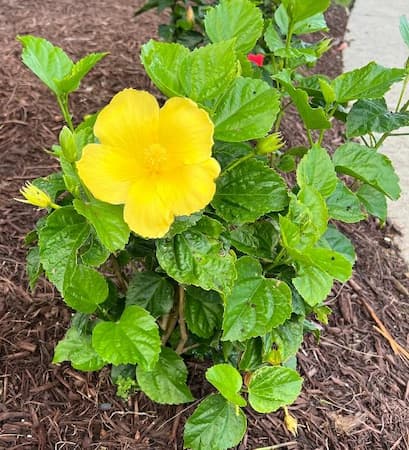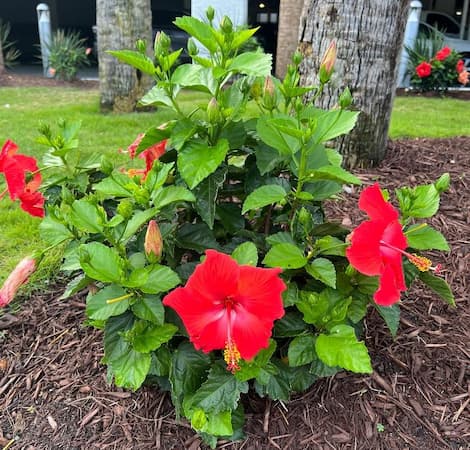How to Grow and Care for Hibiscus Bushes

About Growing Hibiscus Shrub in Your Home Flower Garden
You’re going to love growing Hibiscus flower bushes. Hibiscus shrubs are attractive, warm weather, perennial flowering shrubs. Native to tropical and sub-tropical regions around the world, there are over 200 varieties of Hibiscus. They are members of the Mallow family. The plant produces showy single and double blooms, in a wide range of colors. Although these big blooms are attractive, Hibiscus flowers are short-lived, just 2-3 days. Classified as an herb, Hibiscus shrubs have medicinal and culinary uses. The fragrant blooms are used in sachets and for perfumes, too.
From Sunny Florida to the shores of the Great Lakes. From the Atlantic to the Pacific. There’s a variety of Hibiscus for almost all parts of the continental United States. It is important to note that there are two types of Hibiscus Plants, Tropical and Hardy varieties. The tropical varieties can only be grown in warm weather climates. Frosts and freezes will kill the plant. The hardy varieties will survive low temperatures of 15-20 degrees Fahrenheit.
Hibiscus flowers are popular as container plants in cooler climates. Take the plants inside as cold weather arrives. Then, over-winter them indoors.
Did You Know? Hibiscus is the national flower of Haiti, Malaysia, and South Korea.They are members of the Mallow family.
Hibiscus Flowers Plant Specifications
Flower Colors: Bright red bloom sare the most popular color. Other popular colors include purple, red, yellow, white, and bi-colors.
Flowers Blooms: Summer to early Fall.
Plant Height: Dwarf varieties grow 2-3 feet. The largest varieties grow up to 15 feet tall.
Light Requirements: Full to partial sunlight.
Ideal Soil pH: 5.5- 6.8.
Hardiness Zone: 4 – 11.
Toxicity: The plant is generally considered non-toxic.
Deer Resistant? Yes. Deer steer clear of this plant. Rabbits avoid it, too.
Number of Species: This plant has over 200 species.
Native To: Asia and North America.
Plant Type: Perennials.
Botanical Name: Hibiscus
Other Names: Karkade, Japanese Sorrel, Red Sorrel, Shoe Flower.

Are Hibiscus Flowers Edible?
YES and NO!!
The flowers, leaves, and fruit (calyxes) of some species of Hibiscus plants are edible. However, other species are toxic. Unless you are well-versed on which species of this plant are edible, we recommend you avoid consumption of this plant.
For edible varieties, eat them as you do for spinach as a green, or in recipes that call for spinach. Also use the leaves in teas.

Hibiscus Plant Medicinal and oher Uses
Although gardeners grow Hibiscus shrubs for their beautiful flowers, this versatile plant has medicinal uses, too.
Hibiscus treats cardiac and nerve disorders, to treat constipation, and as a diuretic.
But, that’s not all! Hibiscus is used to make rope. And, the blooms are used in sachets and perfumes.
Light Requirements
Tropical varieties ae accustomed to growing in hot, full sunlight. However, they tolerate partial sunlight. While they like full sun, they benefit from a light afternoon shade.
Hardy varieties grow well in full sunlight to partial shade.
Hibiscus Plant Propagation
Like other flowers and shrubs, Hibiscus is propagated from seeds. It may take a search to find the seeds, as most seed companies do not carry it.
Hibiscus can also be propagated from cuttings. Take a 4-6 inch cutting from new growth or soft wood. Remove leaves, except at the growing tip. Place the cutting in moist soil. It should take root in 7-8 weeks. If started outdoors, grow in a shaded area.
Most people buy young plants at their local garden store or online

How to Grow Hibiscus Flowering Shrubs
As their name suggests, tropical Hibiscus plants grow well in warm and hot regions of the country. Conversely, Hary Hibiscus are better suited for more northerly climate regions.
They are acid-loving plants. Adjusting the soil to the ideal pH range is important for plant health and blooms. Acidity levels can affect flower color.
Provide the plant with rich loam soil. It should drain well. When planting outdoors, mix plenty of compost into the planting site.
Keep the soil moist, not wet. Water during dry weather.
Fertilize plants once a month with a high acid fertilizer. Just before and during the blooming period, use a high phosphorous fertilizer to promote blooms.
Mulch around the plants, to retain moisture, and for an attractive, weed-free appearance.
Did You Know? In Asia, Hibiscus bushes are called the “Shoe Flower” because it is used in shoe polishes.
Pruning Hibiscus Plants
A well-groomed Hibiscus is a fabulous-looking plant. So, prune established plants as needed.
Prune established plants, as needed. Remove dead and yellowing leaves, as well as dead and leggy branches. Prunes plants into a shapely appearance.
Deadhead spent blooms, to allow the plant to direct its energy to plant vigor and to produce more blooms. More on Deadheading Plants.
Growing Hibiscus Plants in Flowerpots
Dwarf and other smaller varieties of Hibiscus plants look great in flowerpots and containers on your patio or deck.
In general, grow them as described in this how-to-grow guide. However, container-grown plants need a little extra attention. Here’s what to watch for:
- Patios or decks can reach a higher, hotter air temperature. The plant may suffer if the temperature gets too hot. So, move the container to a lightly shaded area of your patio or deck when high summer temperatures arrive.
- The soil in flowerpots and containers dries out quickly. Smaller containers dry quicker than larger ones. In dry weather, diligently check for soil moisture every day or two.
- The soil in containers and flowerpots have a limited amount of fertilizer and nutrients available for your plant. Apply a light solution of liquid fertilizer every 3-4 weeks. Or use fertilizer spikes.
Garden Tip: If you go away on vacation, have a neighbor or gardening friend check on all of your container-grown plants regularly.
Insects and Plant Disease
Hibiscus bushes are resistant to insects and disease. If insect or disease problems occur, treat early with organic or chemical insect repellents and fungicide.
Plant Problems – Identify the causes and find the cures.
Overwintering Hibiscus Bushes
In colder regions of the country, overwinter Tropical Hibiscus varieties in a warm and partly sunny location in your home. As you bring the plant indoors, trim the foliage back by about 1/3. Even with trimming, temporary leaf drop is common. Learn more about Leaf Drop.
For hardy varieties, leave them in the ground outdoors. You can cut the plants down to soil level in the Fall or the Spring. A layer of mulch helps to protect the roots during harsh winters.
Related Articles
Also, people who read this article on Hibiscus bushes will like:
Free-to-use Hibiscus Flower Pictures
How to Deadhead Spent Flower Blooms – It encourages new blooms in many flowering plants. And, it gives the plant a neat and tidy appearance.
Plant Problems – Identify the causes and find the cures.
Please support our site. Shop for:
- rmmatthews100@hotmail.com
- 585-721-6528
- Rochester, NY
©1999-2024 GardenersNet.Com, All Rights Reserved

